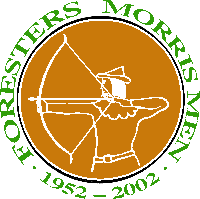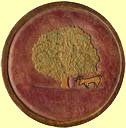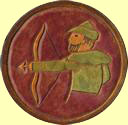Morris dances are
ancient English ritual dances. Long ago these were performed to bring
fertility to the worshippers and increase their harvest, flocks and
herds, and to ensure plentiful children to maintain the strength of
the tribe. They were probably connected with the worship of the Mother
Goddess, and some modern teams of morris dancers represent her by an
accompanying Man-Woman. Our team includes a fool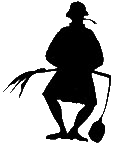 ,
who probably represents the priest who celebrated the mysteries, and
a Man-Beast
,
who probably represents the priest who celebrated the mysteries, and
a Man-Beast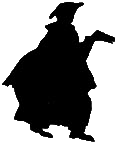 ,
a creature also connected with fertility. Our beast is a stag, as we
come from the area of England associated with Robin Hood and Sherwood
Forest, once the haunt of deer. The deer could be hunted only by the
King or Nobles, but fed Robin and his men.
,
a creature also connected with fertility. Our beast is a stag, as we
come from the area of England associated with Robin Hood and Sherwood
Forest, once the haunt of deer. The deer could be hunted only by the
King or Nobles, but fed Robin and his men.
The dances are
men's dances and came from villages where they were performed at Whitsun
(Pentecost). Changes in industrial development led to many country people
moving to the towns, and as a result most of the traditional teams died
out. In 1899 Cecil Sharp encountered one of the few traditional teams
still existing, and was much impressed by their vitality. He spent the
rest of his life collecting these dances and teaching them to people
who felt that they should be preserved. Gradually clubs sprang up to
maintain the Morris as a living tradition, and, more recently, some
of the traditional village teams have been revived.
The Cotswold hills
are a traditional stronghold of the English Morris with most towns and
villages boasting their own teams up to the last century. English Morris
Dancing was once part of the seasonal magic of the countryside. It was
one.of the functions of the Morris to encourage the earth and everything
within it to revive and flourish Bampton-in-the-Bush Morris Dancers
claim a continuity of several hundred years and we welcome them as we
do Chipping Campden, together with several teams from the Midland Region
to the Festival.
The Cotswolds are by no means the only part of England where Morris
Dancing belongs. In Lancashire and Cheshire we find spectacular Clog
Morris which was frequently performed as part of the Rush Cart procession.
There are also sword dances, and seasonal plays
connected with the death of the old year and the rebirth of the
new, which hark back to pre-Christian beliefs.
See also the transcript
of a BBC programme on morris dancing.
I've also added
to this site some photographs of Cecil
Sharp's original wooden 3-hole pipe, made to a special order for
Sharp by Dolmetsch in the 1920s. When I showed the pipe to Carl Dolmetsch
in the 70s, he said "Oh that one, that was a special. The name
was Sharp. I made six of them for him."
